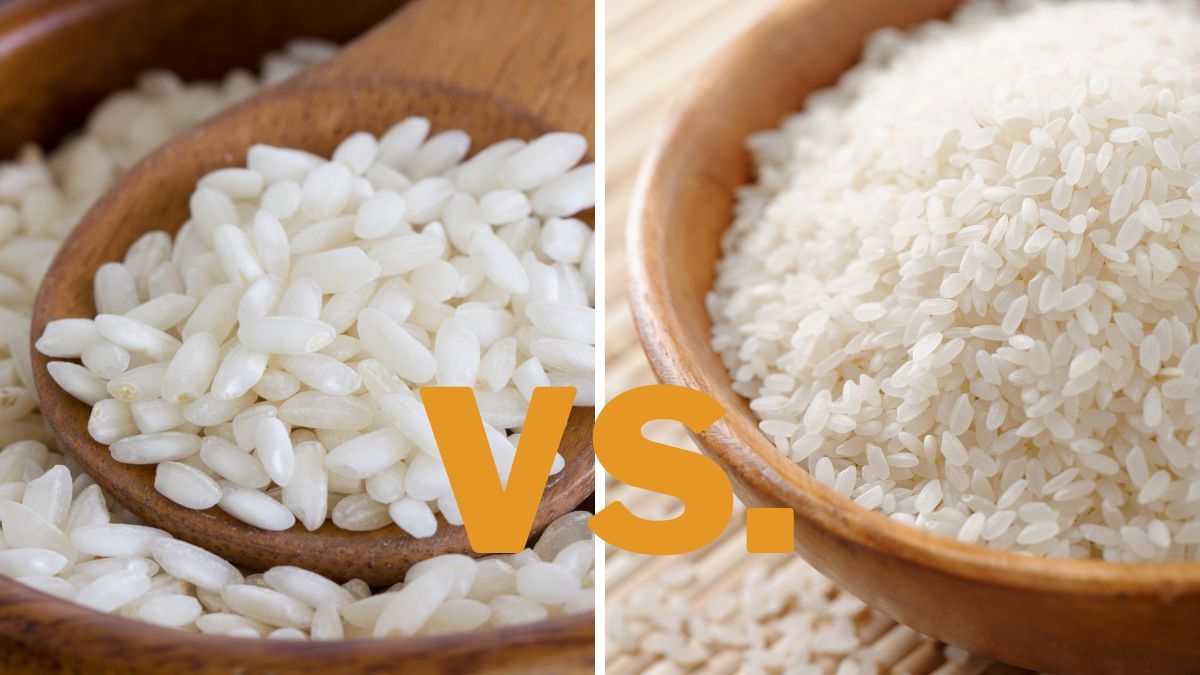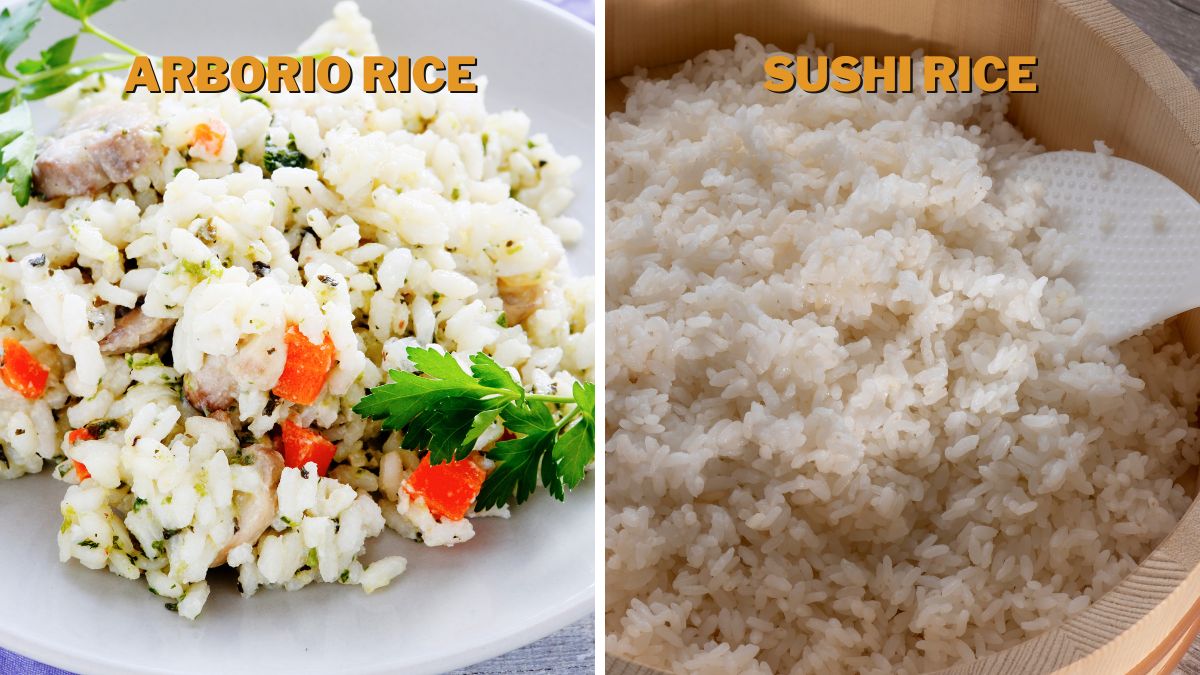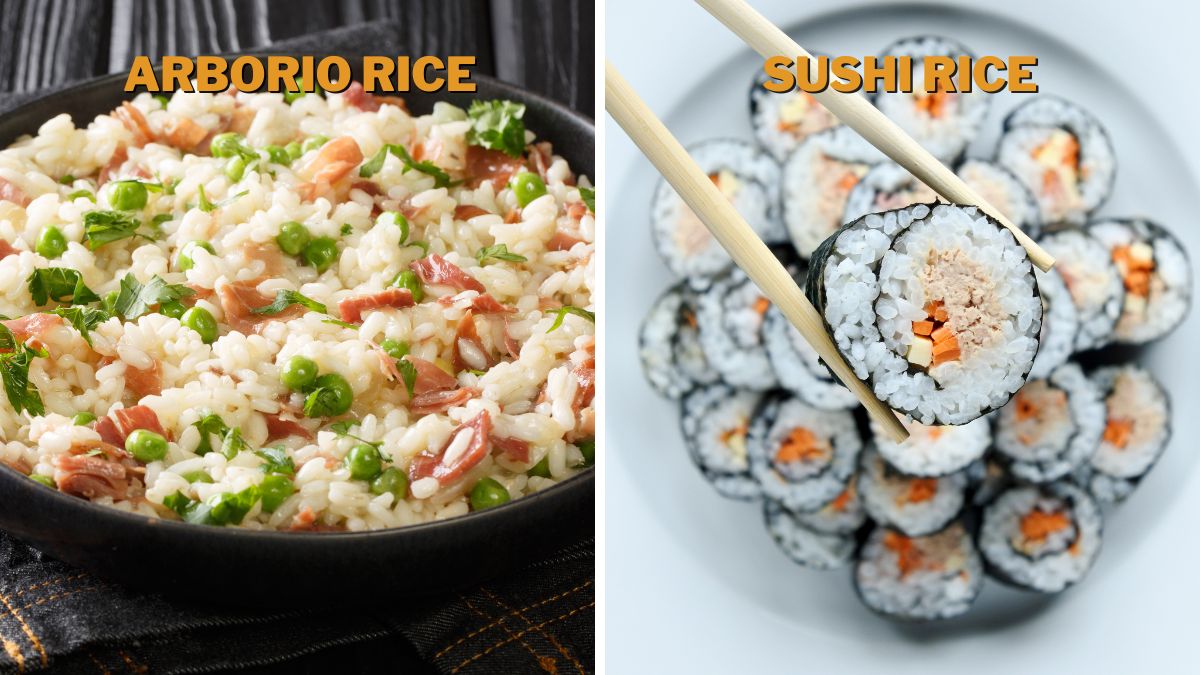Arborio Rice vs. Sushi Rice: Differences & Uses

If you frequently cook rice-based dishes, chances are you’ve noticed the similarities between Arborio and sushi rice. They both have short to medium-sized grains that look rather stubby. But can you actually substitute one for the other? What are the differences between arborio rice and sushi rice?
Arborio rice is starchier, making them perfect for risotto. Sushi rice is stickier, which is ideal for sushi.
Both rice types have more differences that affect their qualities and uses, so let’s examine them further.
What Is Arborio Rice?
Arborio rice is a type of rice that’s historically grown in Arborio, a small commune in Italy’s Piedmont region. The grains are short and oval-shaped, and it contains more starch than most other rice types. Its scientific cultivar name is Oryza sativa japonica, which is related to sushi rice.
I never wash the rice before cooking to take advantage of Arborio rice’s starchiness. Washing them before cooking releases some of the starch within the grain, which I definitely want to keep if I want a creamy risotto.
I also try not to use brown Arborio rice as much because it’s harder to find and doesn’t release as much starch, though it could be a better alternative if you have dietary restrictions.
What Is Sushi Rice?
Sushi rice, just as its name suggests, is a type of rice that’s best suited for sushi. That’s because its grains stick well to each other when cooked, which is vital for maintaining a sushi’s shape and structure.
Japan grows multiple rice varieties across different prefectures, but the most commonly used types are Koshihikari and Hitomebore. Japanese rice farmers also grow other Japonica rice varieties, and some of them are used for other rice-based products such as sake and mochi.
Except for sake, one thing is common about how the Japanese use their rice: they need each grain to be sticky. Considering that they primarily use chopsticks to eat their meal, it’s understandable why they need better cohesion between each grain.
And yes, that is the same Japonica cultivar as Arborio rice. In a way, you could say that Arborio and sushi rice are remotely related to one another.
Taste Test
There aren’t many differences in taste between Arborio and sushi rice. Both have a mild flavor with a slightly sweet profile and are well-suited to absorbing external flavors. Notably, Arborio rice has a subtle nutty taste that’s absent in sushi rice. Some say there’s an underlying acidity in unseasoned sushi rice, but I personally haven’t noticed it.
Personally, I associate Arborio rice with complex, savory flavors, thanks to its usual place in risotto. On the other hand, sushi rice isn’t complete without its signature tangy taste derived from vinegar, sugar, and salt.
Different Appearances
Because both rice comes from the same cultivar, Arborio and sushi rice look similar. Both are round and thicker than other rice varieties, such as Jasmine or Basmati.
However, with a side-by-side comparison, Arborio rice is slightly longer than sushi rice. But sushi rice has a more translucent color when uncooked; it develops a brighter white color when cooked, thanks to the polishing process it receives during processing. Arborio rice isn’t processed as much to keep much of its starch intact.

Differences in Cultivar and Origin
Although Arborio and sushi rice are both varieties of the Japonica cultivar, their native region and types are different.
As mentioned earlier, Arborio rice historically grows in its namesake Italian town, Arborio. Nowadays, the rice is also grown in areas outside of Italy, but its specific strain retains the name “Arborio” to differentiate it from the rest. And considering its culinary use, that’s a vital identifier for consumers.
On the other hand, multiple varieties of sushi rice are grown in Japan and other countries. Some of the most popular Japonica cultivars used for sushi are Koshihikari and Hitomebore, which are farmed in Japan. Calrose and Nishiki, grown in California, can also be used for sushi; the same applies to Yume-Nishiki from Northern Italy.
Best Uses for Arborio Rice
The first recipe that comes to mind when I hear “Arborio rice” is risotto. Regardless of whether I’m making mushroom or chicken risotto, I need Arborio’s immense starch reserves if I want to make the dish as naturally creamy as possible.
However, risotto’s not the only use for Arborio rice. I also use it when I make Arancini (fried rice balls) and the popular springtime dish, Risi e Bisi (Venetian Rice and Peas). Imagine just how rich each bit of Arancini is when made with Arborio rice and how hearty a spoonful of Risi e Bisi is with Arborio’s signature starchiness. I even sometimes use it in Spanish Paella.
Best Uses for Sushi Rice
Given its name, sushi rice’s use may be obvious, but you can use it in other dishes. It’s a perfect accompaniment to Japanese curry, and I also love using it when cooking various rice bowls such as Gyudon (beef bowl), Katsudon (fried pork cutlet bowl), and Oyakodon (chicken and egg bowl).
How about using sushi rice for a lovely serving of Hawaiian Poke? When seasoned with vinegar, sugar, and salt, sushi rice in a Poke bowl is like eating deconstructed sushi. Sticky rice helps ensure that you’ll always have a nice heaping of rice on your chopsticks (or spoon if you can’t use one) every time you take a bite.
And whenever I’m feeling creative and need to make snacks, the stickiness of sushi rice helps me create an onigiri that won’t fall apart once I take a bite. Nobody likes onigiri that won’t hold its shape; it takes away the fun of eating a stuffed rice ball.

Can You Substitute Arborio Rice with Sushi Rice?
I’ve never been in a situation where I needed an Arborio rice substitute (thankfully!), but I do know I can use sushi rice in a pinch. The downside is that I’ll lose the risotto’s creaminess because of its lower starch content, so I’ll either have to accept that or artificially thicken the dish with cream. It’s not ideal, but it’ll do if I’m in a hurry.
But if I’m at the store and can’t find Arborio rice, I try to look for Carnaroli or Vialone Nano. Carnaroli also has a high starch content but is more expensive than Arborio. Vialone Nano, on the other hand, absorbs a lot of moisture, which can help contribute to a thick, though clumpy, risotto. However, it’s not as starchy, so that’s a trade-off to be considered.
If all else fails and I can’t source any rice or just don’t feel like using it for that day, farro or pearled barley also works well for risotto. Farro lends a prominent nutty taste throughout the dish, while pearled barley offers a starchy background similar to rice.
Can You Substitute Sushi Rice with Arborio Rice?
Substituting sushi rice with arborio rice could work, but it depends on the situation.
Arborio rice falls short of that task for sushi or onigiri where the structure is crucial because it’s not sticky enough. It might look similar, but you’ll need to press the rice together even harder to ensure everything sticks together. And there’s no guarantee that it will keep its shape once you take a bite. Try it at your own risk.
But I don’t mind using Arborio rice as an alternative for rice bowl dishes where the stickiness isn’t a factor. It still does the job well – it absorbs the flavors of the sauces well, and the extra starch makes each spoonful much more enjoyable.
Esteemed Japanese chefs won’t recommend substituting sushi rice with other kinds, but I don’t see a problem. At the end of the day, rice is there to accompany and enhance a delicious sauce.
Don’t forget that other Japonica varieties, such as Calrose and Nishiki, can also work as a substitute for any dish that needs sushi rice. And depending on the store, finding Calrose rice might be easier than finding Arborio rice.
